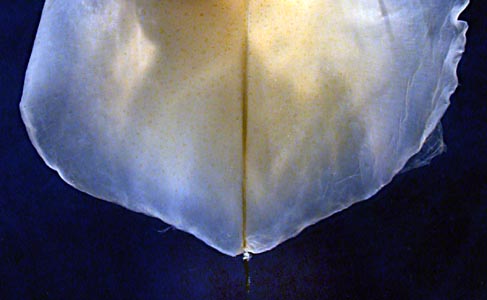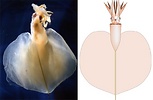Magnapinna atlantica
Introduction
Magnapinna atlantica (formerly known as Magnapinna sp. A on this page) is based on two specimens taken from the North Atlantic. The holotype (US National Museum of Natural History cat. no. USNM 1086800), 59 mm ML, immature female, was captured in the Gulf of Mexico at 27°09’N, 86°07’W on 16 Sept., 1995. It was captured intact with damage only to the tips of the appendages. The paratype (Natural History Museum, London, cat. no. BMNH 20060134) 53 mm ML, immature male, was captured over the mid-Atlantic Ridge near the Azores at 37°14'N. 32°18'W on June 21, 1997.
Diagnosis
A magnapinnid with:
- Tentacle bases narrower than adjacent arm bases.
- Proximal tentacle without suckers but with glandular structures.
- Pigment mostly in functional chromatophores
Characteristics
- Arms
- Arms short, thick, weakly muscled and decreasing abruptly in diameter distally to form sucker-bearing filaments (mostly lost due to damage)
- Proximal-arms with suckers in two series (except at tips in some proximal-arms), ocasionally appearing slightly irregular.
- Tentacles
- Proximal-tentacles more slender than arms IV.
- Proximal- tentacles short, thin and without suckers; distal-tentacles (filaments) very narrow and bearing small suckers mostly around 0.08 mm in diameter.
- Distal third of proximal-tentacle with large, apparently glandular, lobes.
- Fins and tail
- Fins extremely large, about 90% of the mantle length.
- Fins appear not to have been drawn-out into V-shaped point.
- Tail presently a bare gladius with tip missing; extends at least 4 mm beyond fins.
- Pigmentation
- Head, mantle, funnel, collars and fins with numerous scattered chromatophores.
Figure. Left - Oral view of the brachial crown of M. atlantica, holotype. Right - Oral view of the left proximal tentacle and arm IV of M. atlantica, holotype, showing their relative thicknesses and the glandular regions of the proximal tentacle (yellowish tint). The distal tentacle and arm are missing. Note the broad lateral membrane on arm IV. Photographs by R. Young.
Figure. Dorsal view of the posterior half of the fins of M. atlantica showing fin shape and the short gladius extending beyond the fins.
Figure. Dorsal view of a portion of the fins of M. atlantica, holotype, showing large chromatophores.
Comments
This description is based on the holotype. More details of the holotype's description can be found here. The paratype is a smaller specimen (53 mm ML) and in less perfect condition. Information on the paratype can be found here.
M. atlantica differs greatly from M. pacifica in the much thinner tentacles, the lack of suckers on the proximal tentacles, the presence of large, glandular regions on the proximal tentacles, two sucker series on the arms rather than three to four and numerous other features. These differences are great enough to suggest that they may belong in separate genera. The thin, bare proximal-tentacles are shared with the other Atlantic species.
References
Fischer, H. and L. Joubin. 1907. Expéditions scientifiques du TRAVAILLEUR et du TALISMAN. Céphalopodes, 8: 313-353.
Hardy, A. 1956. The Open Sea. Fisher, J., J. Gilmour, J. Huxley, M. Davies, and E. Hosking, Eds., Collins, London, 1956.
M. Vecchione, R.E. Young, A. Guerra, D.J. Lindsay, D.A. Clague, J.M. Bernhard, W.W. Sager, A.F. Gonzalez, F.J. Rocha, and M. Segonzac. 2001. Worldwide observations of remarkable deep-sea squids. Science, 294: 2505-2506.
Vecchione, M. and R. E. Young. 2006. The squid family Magnapinnidae (Mollusca; Cephalopoda) in the North Atlantic with a description of Magnapinna atlantica, n. sp.. Proc. Biol. Soc. Wash. 119 (3): 365-372.
Title Illustrations

| Scientific Name | Magnapinna atlantica |
|---|---|
| Location | Gulf of Mexico, 27?45'N, 88?31'W, at 1940 m depth |
| Reference | Vecchione, M. and R. E. Young. 2006. The squid family Magnapinnidae (Mollusca; Cephalopoda) in the North Atlantic with a description of Magnapinna atlantica, n. sp.. Proc. Biol. Soc. Wash. 119 (3): 365-372. |
| Specimen Condition | Preserved |
| Sex | Female |
| View | Ventral/dorsal |
| Size | 59 mm ML |
| Type | Holotype |
| Copyright |
© Richard E. Young

|
About This Page
Page copyright © 2005
- First online 16 August 2005
- Content changed 30 October 2006
Citing this page:
Tree of Life Web Project. 2006. Magnapinna atlantica . Version 30 October 2006 (under construction). http://tolweb.org/Magnapinna_atlantica/52204/2006.10.30 in The Tree of Life Web Project, http://tolweb.org/












 Go to quick links
Go to quick search
Go to navigation for this section of the ToL site
Go to detailed links for the ToL site
Go to quick links
Go to quick search
Go to navigation for this section of the ToL site
Go to detailed links for the ToL site